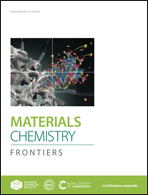Construction of supramolecular polymer hydrogel electrolyte with ionic channels for flexible supercapacitors†
Abstract
Creating ion-transport channels in the polymer hydrogel matrix is an efficient method to improve conductivity. However, the traditional approach of modifying the side chains of the polymer to improve the mobile ions still delivers low ionic conductivity. Herein, a conductive self-healable hydrogel electrolyte (PVA–GB) with a three-dimensional network is designed and prepared via mixing supramolecular gel guanosine (G)–boric acid (B) in the polyvinyl alcohol (PVA) matrix. As a natural K+ ion channel, the GB hydrogel cross-links with PVA via a dynamic borate ester and hydrogen bonding. As a result, the PVA–GB hydrogel with an appropriate amount (112 mg) of G displays higher ionic conductivity (70 mS cm−1) than the original PVA hydrogel (10.3 mS cm−1). It also exhibits fast self-healing capability that repairs scars in less than 1 min without other stimulation. Furthermore, when the optimized PVA–GB hydrogel is used as the electrolyte for an active carbon-based all-solid-state supercapacitor device, it shows a high capacitance of 209.1 F g−1 and nearly 100% capacitance retention after three cycles of cutting and healing. Thus, this work provides a promising supramolecular polymer hydrogel with high conductivity and self-healing ability for energy storage devices.



 Please wait while we load your content...
Please wait while we load your content...